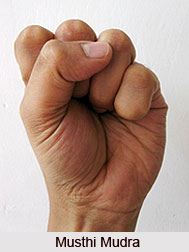 Musthi Mudra is also known as "Fist Mudra". Musthi is a Sanskrit word meaning "closed hand" or "fist". Musthi Mudra, the representation of fist acts as an aid to digestion complaints. Most of the problems arise from aggression. Aggression causes many physical complaints, such as a weak liver, problems with digestion or constipation, tension, heart complaints, etc. The aggression is controlled by practicing mudras. Our body has natural tendency to react to negative emotions such as anger, aggression, fear, irritation and frustration by closing fist.
Musthi Mudra is also known as "Fist Mudra". Musthi is a Sanskrit word meaning "closed hand" or "fist". Musthi Mudra, the representation of fist acts as an aid to digestion complaints. Most of the problems arise from aggression. Aggression causes many physical complaints, such as a weak liver, problems with digestion or constipation, tension, heart complaints, etc. The aggression is controlled by practicing mudras. Our body has natural tendency to react to negative emotions such as anger, aggression, fear, irritation and frustration by closing fist.
Steps of Musthi Mudra
Musthi Mudra helps to get rid of accumulated emotions. Suppressed anger, frustration, constant irritation and negative emotions can be relieved by regular practice of Musthi mudra. This mudra is practiced with both hands. One can feel the difference in just 5 minutes.
•Firstly clench the fingers to form a fist.
•Now place the thumb over the ring fingers.
•Do this with each hand.
•Do as and when needed, or do three times a day for 15 minutes.
In this way it reacts and release out negative emotions which gets accumulated into the body.
Benefits of Musthi Mudra
Musthi mudra is good for digestion. The Musthi Mudra activates the liver and stomach energy, promotes digestion and helps cure constipation. This mudra helps in releasing body tensions and accumulated emotions. The fist is a symbol for anger, aggression or threat. Regular practice of this mudra helps to release accumulated irritation and suppressed anger therefore improves health of the liver, lowers high blood pressure and reduces heart complaints.
This article is a stub. You can enrich by adding more information to it. Send your Write Up to content@indianetzone.com




















